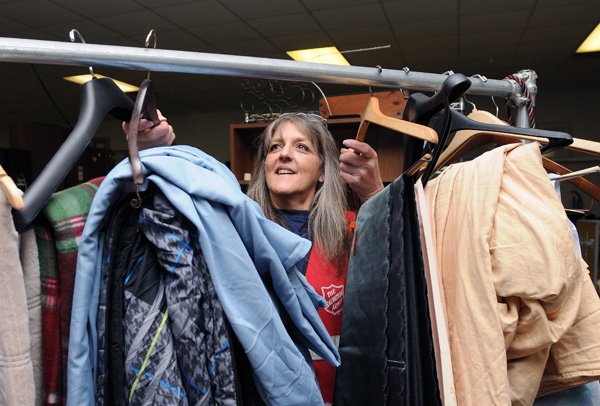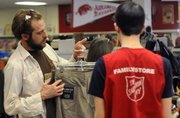Maj. Tim Williford recognizes some of the faces showing up at Salvation Army thrift stores, free meals and shelters around Northwest Arkansas. Just a few years ago, those faces stopped by with checks and donations or to volunteer time and services to help the homeless.
Now, they’re seeking help.
“It’s costing our average donor more today to fill the gas tank, pay the utilities and go to the grocery store. With less disposable income, they’re finding it hard to write us a $25 or $50 check,” he said. “In a lot of cases, one setback puts them in a position where they need assistance themselves.”
The scenario is repeated at charitable organizations around the region, and shelters have been particularly hard-hit by the double whammy of increased need and declining cash donations, said Susan Neyman, president of the regional Association of Fundraising Professionals.
“Programs, you can put in a box and explain in simple terms to a donor or define on a grant application. That’s not the case when you’re looking for overhead and operating money for shelters,” Neyman said. “Donors want to see a tangible result, and that can be harder to demonstrate when you’re talking about operating money.”
Web Watch
Shelter Series
Visit nwaonline.com/shelter for photo galleries of the shelters and previous stories from this series.
About 30 percent of the requests on Ken Mourton’s desk seek support for shelters, while many of the others come from programs that provide assistance to people either in shelters or in similar situations.
“We get so many requests from groups who work with the homeless, with battered women, abused children, the elderly or handicapped,” said Mourton, chairman of Bikes, Blues & BBQ, an annual motorcycle rally supporting area charities. “There’s a pattern over the years, a core set of groups who consistently need assistance.”
While attendance at the rally appears to be growing each year, each attendee seems to be spending less in the last few years, Mourton said.
“If we want to grow our giving, we’ve got to keep attracting more folks to bring in the same number of dollars,” Mourton said.
There’s no lack of major philanthropists in Northwest Arkansas, but they are becoming increasingly discerning about what they support, so not every group can count on the big donations, Neyman said.
“The smaller donors are where everyone’s seeing a big drop-off, and there’s no fallback position to raise that pool of money,” she said. “It’s important to articulate the change in need over the last few years, and for shelters, that means bringing people in and physically showing them the space and the occupants.”
Potential donors are just as important, if not more so, than current and past donors, Neyman said.
“Folks just have to be aware of new possibilities because there’s no guarantee year to year that you can depend on the same sources of support,” she said. “These organizations can’t just plan to go back to the same wells again and again.”
Capital projects, such as new buildings, can often be pitched to larger, out-of-area foundations and donors, but operating costs and program support usually come from local sources, she said.
While big-ticket donations usually receive the most attention, it’s the many smaller ones that really add up, Williford said.
“We have a $3 million budget, and only about 10 percent of it comes from large donations by individuals or corporations,” he said. “The rest is made up by smaller personal donations and government grants, both of which have taken a steep slide.”
Fundraising events often help bring in the dollars that keep organizations running, Neyman said.
“Holding an event is a good way to bring in money for the organization as a whole rather than for a specific purpose or program,” she said. “It’s a good way to cover the gray areas that don’t appeal as much to individual donors.”
While cash donations are down, in-kind donations haven’t seen much of a dip even as the economy soured.
“People still give stuff. They see it as a way they can make a difference without hitting their own checkbook,” Neyman said.
In-kind donations can either be used directly, such as food, or indirectly, Williford said.
Like many other organizations, the Salvation Army runs a thrift store. Much of the store’s inventory is made up of items donated by individuals, although the store also makes extensive use of a large truck donated by J.B Hunt.
“We can sell those things, then take the cash and use it toward our biggest funding needs,” Williford said. “Given the current cash-giving situation for our programs versus the shelter, we’re relying more and more on the income from the store to support our shelter because that’s our biggest cash-versus-need gap.”
Editor’s Note: On any given night, shelters in Northwest Arkansas hold hundreds of our neighbors. No two people travel the same road to a shelter, but once there, they all must rest their heads in strange beds. Though the haven is by necessity temporary, the hope is that it somehow helps them establish long-term stability in their lives. For eight days ending today, NWA Media has featured a different area shelter each day, giving readers an idea of life inside. Today, we explore the common problem of raising money to keep them open.




